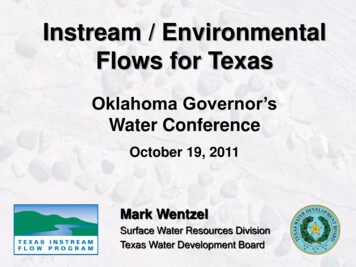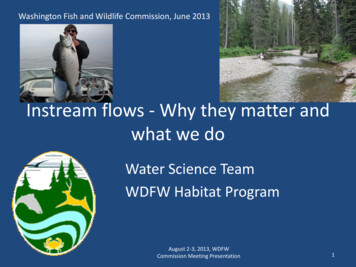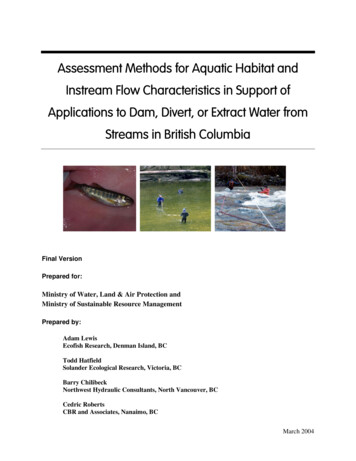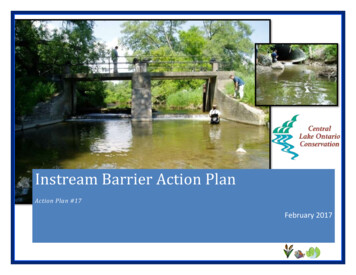
Transcription
Instream / EnvironmentalFlows for TexasOklahoma Governor’sWater ConferenceOctober 19, 2011Mark WentzelSurface Water Resources DivisionTexas Water Development Board
Environmental Flows for Texas Freshwater Inflows – Bays and Estuaries Instream Flows – Rivers and Streams
Instream Flows in Texas 1957 – Water planning (TWDB) 1985 – Water rights permitting (TCEQ),Recommendations (TPWD) 1997 – SB1 – Regional water planning 2001 – SB2 – Studies to determine flowconditions for a Sound EcologicalEnvironment (TCEQ,TWDB,TPWD) 2007 – SB3 – Local (rapid) assessmentof environmental flow requirements(with future refinement)
SB2 Texas Instream Flow ProgramCurrent Priority Studies Lower Sabine Middle & Lower Brazos Lower San AntonioStudy DesignsCompleted Studies - 2012-13Remaining Priority Studies Middle Trinity Lower GuadalupeCompleted Studies - 2016Second Tier Studies Upper Guadalupe Neches Upper Sabine Bois d’ArcCompleted Studies - ?
SB3 E-flowsProcess2008-20112009-20122010-2013
Lessons Learned Pre Senate Bill 2 (individual agency programs)Project specific studies From Senate Bill 1 (Regional Water Planning)Local stakeholders leading regional process From Senate Bill 2 (Texas Instream Flow Progarm)Regional studies with combined agencyresources and local stakeholder input From Senate Bill 3 (Eflows Process)Local stakeholders and scientists leading theprocess for basin-bay systems using bestavailable science plus refinement over time
Lessons LearnedPre Senate Bill 2 Different disciplines/agencies (Biology/Parks andWildlife and Hydrology-Engineering/WaterDevelopment Board) think/speak/act completelydifferently Agencies as adversaries don’t get a lot done(instream flow activities) Agencies as partners can get results (FreshwaterInflow Program) Impacts of projects extend throughout a stream orriver system (one or two project specific studiesequals one study of an entire sub-basin)
Lessons LearnedFrom Senate Bill 1 Water planning (like developing environmental flowrecommendations) is part science and part localgoals and values With assistance, regional stakeholders can do adecent job with the science Regional stakeholders do an excellent job with localgoals and values Regional stakeholders take the results they developmuch more seriously than the ones state agenciesdevelop for them
Lessons LearnedFrom Senate Bill 2
Texas Instream Flow ProgramSenate Bill 2 (2001)“ conduct studies and analyses to determineappropriate methodologies for determiningflow conditions in the state’s rivers andstreams necessary to support asound ecological environment.”
Stakeholder InvolvementCollect Baseline Informationand EvaluateGoal for River Sub-BasinObjectives Required to Meet GoalGoal Development Consistentwith Sound EcologicalEnvironmentIndicators to Measure ProgressStudy DesignConceptual ModelMultidisciplinaryData Collection andEvaluationData Integrationto Generate FlowRecommendationsStudy Report
Lessons LearnedFrom Senate Bill 2 Local stakeholder input on goals, objectives, andindicators makes for a better study
Hydrology proachWaterQualityBiologyConnectivityFlow Regime
Lessons LearnedFrom Senate Bill 2 Local stakeholder input on goals, objectives, andindicators makes for a better study There is a synergy when different disciplines andagencies work together Rivers and streams are more complex than wethought (single flows to flow regime)
Scientific PeerReviewNational Academyof Sciences (2005)Review of the TIFP “conforms with the best practices” “will provide enormous benefits tothe state” identified several opportunities forimprovement
Lessons LearnedFrom Senate Bill 2 Local stakeholder input on goals, objectives, andindicators makes for a better study There is a synergy when different disciplines andagencies work together Rivers and streams are more complex than wethought (single flows to flow regimes) Scientific peer review is worth its weight in gold
Lessons LearnedFrom Senate Bill 2 Local stakeholder input on goals, objectives, andindicators makes for a better study There is a synergy when different disciplines andagencies work together Rivers and streams are more complex than wethought (single flows to flow regimes) Scientific peer review is worth its weight in gold We can learn from others’ successes and failures
Lessons LearnedFrom Senate Bill 3
SB3E-flowsProcessEnvironmentalFlows AdvisoryGroupBasin & BayArea StakeholdersCommitteeStandards, Strategies,Work PlansScienceAdvisoryCommitteeBasin & BayExpert ScienceTeamEnvironmental FlowRegimes
Lessons LearnedFrom Senate Bill 3 Appoint your Science Advisory Committee earlyand kept it going
SenateBill 3Basin & Bay AreaStakeholdersCommitteeBasin & BayExpert ScienceTeam OtherWater NeedsRecommendedStandards andStrategiesEnvironmentalFlow Standardsand Set-AsidesScienceEnvironmentalFlow Regimes OtherFactors
Lessons LearnedFrom Senate Bill 3 Appoint your Science Advisory Committee earlyand kept it going (there aren’t as many experts outthere as you might think) Its very difficult for scientists to come up with flowrecommendations in only one year
Lessons LearnedFrom Senate Bill 3 Appoint your Science Advisory Committee earlyand kept it going (there aren’t as many experts outthere as you might think) Its very difficult for scientists to come up with flowrecommendations in only one year Its even more difficult for stakeholders to come upwith recommendations in only six months
Lessons LearnedFrom Senate Bill 3 Appoint your Science Advisory Committee earlyand kept it going (there aren’t as many experts outthere as you might think) Its very difficult for scientists to come up with flowrecommendations in only one year Its even more difficult for stakeholders to come upwith recommendations in only six months Results are improved with better available scienceand stakeholder relationships not necessarily moreplentiful water
Lessons Yet to be Learned Balancing the needs of a complex ecosystemversus a relatively simple regulatory framework What to do with high pulse and overbankcomponents of flow regime How to provide inter-annual variability How to provide flows in over allocated systems How to bridge a language barrier between waterrights regulators/holders (firm yield) and instreamflow scientists/engineers (inter- and intra-annualflow variability)
Questions?
Water planning (TWDB) 1985 - Water rights permitting (TCEQ), Recommendations (TPWD) 1997 - SB1 - Regional water planning 2001 - SB2 - Studies to determine flow conditions for a Sound Ecological Environment (TCEQ,TWDB,TPWD) 2007 - SB3 - Local (rapid) assessment of environmental flow requirements (with future .











